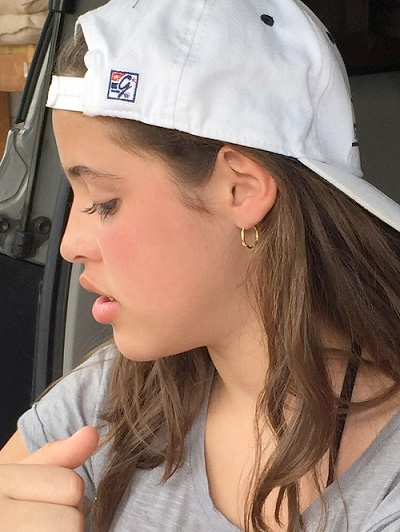Victoria Vega – The ‘Miracle Girl’
You would never know from talking to Victoria Vega that this bright, self-assured young woman had ever been sick. But as a toddler, she was wracked by as many as 28 epileptic seizures a day.
Today, Victoria is a healthy young woman who has been seizure-free since undergoing brain surgery. But it wasn’t an easy path for her or her family.
Childhood Epileptic Seizures
 When Victoria Vega was two years old, she had her first epileptic seizure. Victoria began having regular epileptic seizures. Despite multiple medications, her seizures were inadequately controlled, resulting in an average of 2 to 3 seizures per day and sometimes many more.
When Victoria Vega was two years old, she had her first epileptic seizure. Victoria began having regular epileptic seizures. Despite multiple medications, her seizures were inadequately controlled, resulting in an average of 2 to 3 seizures per day and sometimes many more.
For Victoria Vega and her family, there was a definitive “before and after.” Before “we had a normal life,” said her mother, Laura. By the time her seizures became regular and uncontrollable, as well as resistant to medication, her mother knew that “the best solution for her daughter was to have cerebral surgery.”
“We tried different medications, but none of them seemed to work,” recalls her mother, Laura Vega. “We finally realized that surgery was our only hope.”
That’s when Victoria and her family came to Dr. Arno Fried, who did Victoria’s surgery. Laura couldn’t have found a more capable or more sympathetic surgeon. He is one of just a handful of neurosurgeons in the country to be board-certified in both general neurosurgery as well as pediatric neurosurgery.
Surgery to Seizure-Free
In 2006, at the age of 3, Victoria was evaluated by Dr. Arno Fried. Dr. Fried planned a two-part operation. During the first procedure, he would plant electrodes in Victoria’s brain that would be used to track the source of her convulsions. During the second, he would remove the misfiring tissue.
Dr. Fried performed the first surgery on Victoria on December 1, 2006, placing subdural grids on the right fronto-temporal and parietal area of her brain in order to map her seizures and her vital functions, such as motor (movement) and language.
When Dr. Fried and his colleagues mapped the seizures, they found to their dismay that it emanated from a point on the motor strip, the part of the brain that controls bodily movements. “If we took too much tissue, we ran the risk that Victoria could be paralyzed,” he says.
After several seizure results were obtained during the study, it was determined that a focal resection could be done to remove the seizure focus.
Laura Vega and her husband, Alex, were naturally apprehensive. “I was crying when he told us,” Laura recalls. “But he assured us that he would treat my daughter the way he would treat his own child. That made a difference.”
Victoria was taken back to the operating room with Dr. Fried performing surgery on December 15 for removal of the grids and resection of the brain responsible for her seizures.
The operation went extremely well. Laura says, “that was the last time I saw her convulsing.” Victoria has been seizure-free ever since.
The Gift of Childhood
 As anticipated, she had some initial weakness on her left side, but recovered her strength in just a few months. Now she likes nothing more than to play lacrosse with her big brother and ride her boogie board at the Jersey shore.
As anticipated, she had some initial weakness on her left side, but recovered her strength in just a few months. Now she likes nothing more than to play lacrosse with her big brother and ride her boogie board at the Jersey shore.
Laura explains in the video below that it is hard to think of one’s daughter getting brain surgery; “the first feeling is terror,” she explains. But she said the doctors gave her confidence when they said they were ‘going to treat her as if she were their own daughter.’
Dr. Fried and the team at Advanced Neurosurgery Associates are aware of the emotional impact. From Dr. Fried’s point of view, comforting Victoria’s parents is an essential part of being a pediatric neurosurgeon.”Because we’re dealing with children, we’re really treating the whole family,” says Dr. Fried.
“La Niña Milagro” (The Miracle Girl)
Despite the end of the seizures, there was a period following the surgery that Victoria had to recover. “She lost feeling in her left side and needed a walker. We were told that her recovery would be six months until she could walk normally.”
But when Victoria walked into the doctor’s office seven weeks following the surgery, he was in disbelief. “He began to call her The Miracle Girl–’La Nina Milagro,'” as she explains. Laura concludes by recommending her daughter’s caretakers for their sincerity and compassion. “I say from the bottom of my heart, you can go to them and find what you need.”
You can watch her video below (in Spanish) or download her story (in English).
Viviendo una vida normal después de la cirugía de la epilepsia: La historia de “La Niña Milagro.”
Para ver esta historia y otras páginas en otro idioma, por favor haga clic en “Select Translate” al lado de la barra de búsqueda en la parte superior de nuestra página.